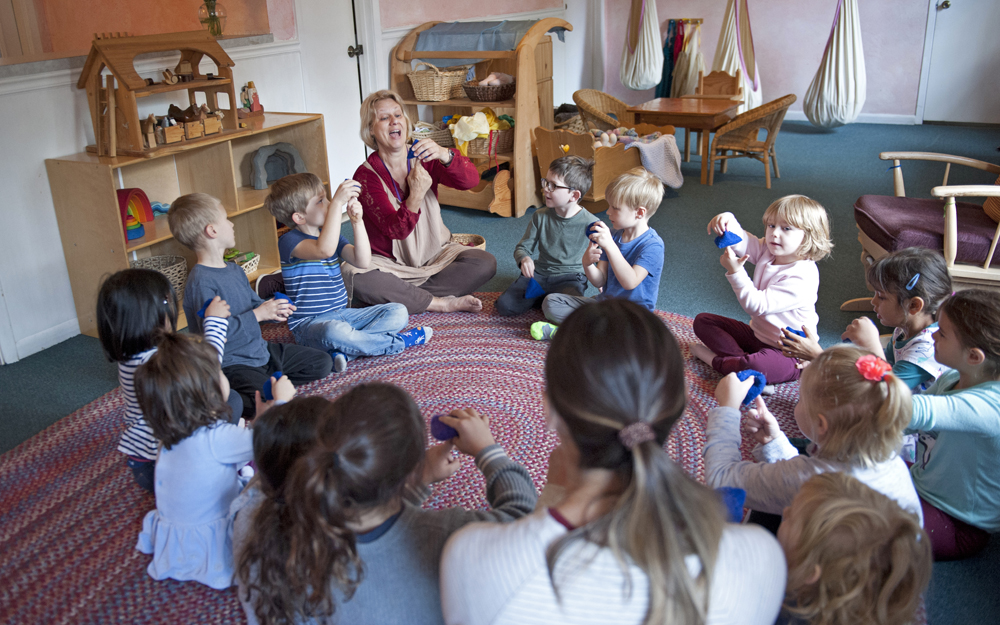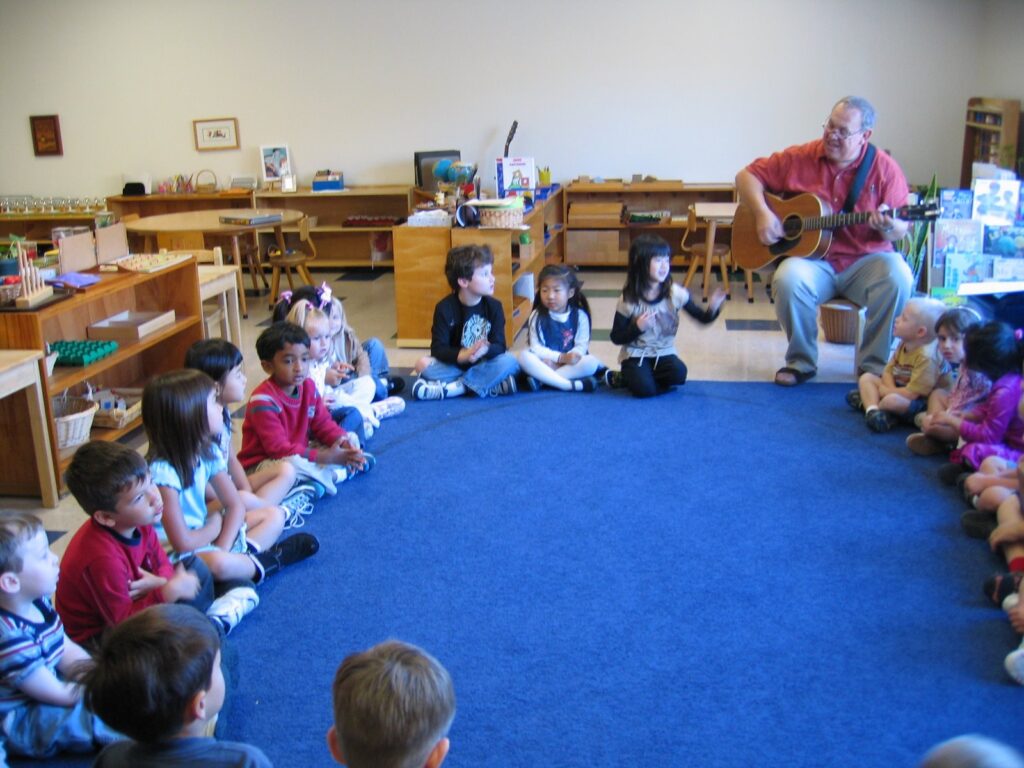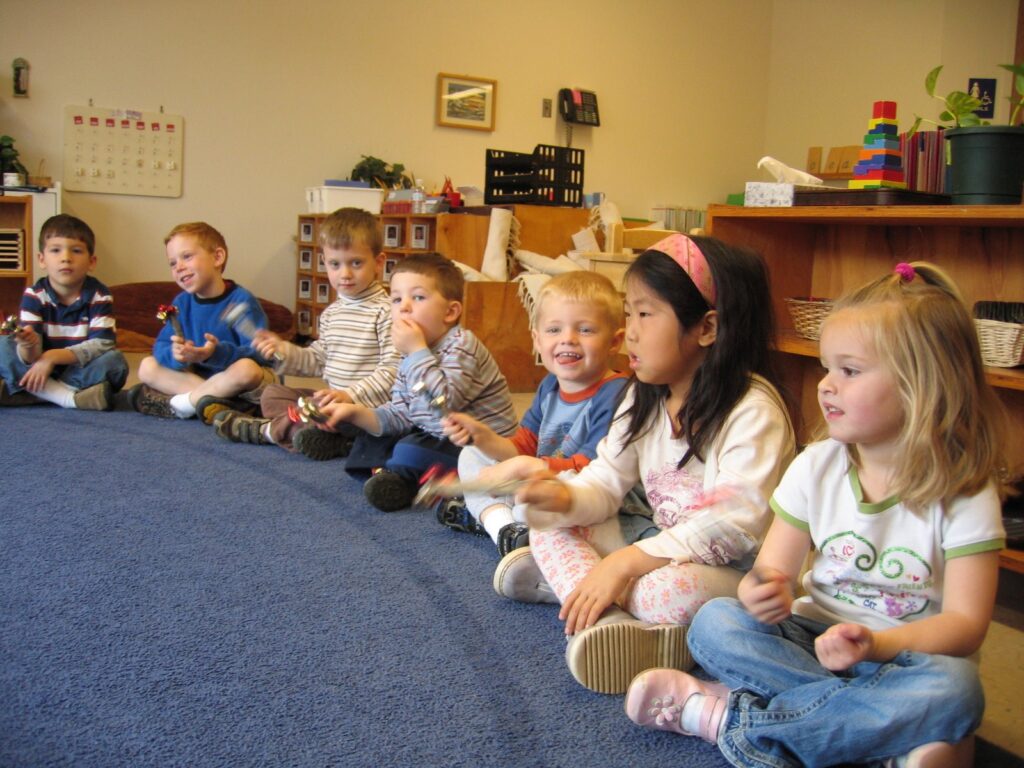When you walk into a Montessori classroom, you will soon realize that it is not your typical school classroom. Instead of desks in neat rows, work tables are sporadically placed throughout the room for use by the children as necessary. This is to encourage children to work by themselves on tasks that interest them. Thus, the only time the students get together as a group is during a period called circle time.
Montessori Circle Time is a period within the school day when the children are gathered together with the teacher to do group activities. It is called circle time as children and teachers sit in a round formation facing each other. Circle Time has an open format, but can include such activities as games, singing, lessons, and routines. A typical Montessori school day begins with Circle Time.
Read on to learn more about the different ways Montessori circle time enhances children’s school experience.

Purpose of Circle Time in Montessori
Circle time is a multi-purpose period that normally lasts approximately 30 minutes when the teacher can direct the flow of the class or lessons. Some of the ways circle time is used are:
- to set the tone for specific periods of the school day, either to liven up or quiet down
- to encourage cooperative activities to the children
- to build a sense of community among the children
- to teach group lessons
While the Montessori method’s focus is in training the child to work independently and in a self directed manner, Dr Montessori acknowledges the need for cooperative interactions that groups provide:
“…there would be all kinds of artistic occupations open to free choice both as to the time and the nature of the work. Some must be for the individual and some would require the cooperation of a group. They would involve artistic and linguistic ability and imagination,… ”
Maria Montessori, From Childhood to Adolescence,
Circle Time may include lessons in the form of songs, games, and other activities that foster interaction among classmates and teachers. It is also used for specific events such as at the beginning of the school year to teach children about the classroom routines, or for birthday celebrations.

When does Circle Time occur?
There are three main points in the Montessori school day where circle time is usually carried out. There are no hard and fast rules for circle time, but they are typically done first thing in the morning, in the middle of the day, or before the end of the school day.
Morning Circle Time
Teachers usually start the Montessori school day with circle time by gathering the students in a circle and singing songs that set the tone for the day. The song is usually one that the children normally sing or one that is related to their current lesson. For morning circle time, songs such as “Good Morning” or “What’s the Weather Like Today?” are most utilized.
Middle of the Day Circle Time
Circle Time can also be done in the middle of the school day to get the children back on track and focused on their work. When done at this time, the teacher can introduce another song or activity in line with the lesson plan that helps break up monotony that may have set in during the work day.

End of the Day Circle Time
Circle time at the end of the day is usually carried out to help the children get ready for school pick up. This includes prompting the children to put away the materials they have been using and cleaning their workspace, as well as getting their belongings ready. Another song can then be sung to end the school day on a high note.
Montessori Circle Time Activities
To make learning fun and interesting for the children, circle time activities are as diverse and creative as the teachers’ imaginations. What all activities have in common are they all aim to educate and make learning interesting for the children in a group setting.
Circle Time Calendar/Board
Morning circle time is also the time children and teachers go through the circle calendar or board, a tool that teaches children about dates and seasons. The calendar is a perpetual calendar where the day, month, year, and seasons/weather can be changed on a daily basis. Students do this exercise at the beginning of each school day, participating in setting the date, and season on the calendar. This activity helps reinforce the lesson of the passing of time and the changing of the seasons. There are many variations of the circle calendar and this can be fashioned from materials at school or bought from one of many Montessori school suppliers.

Music
Teachers use morning circle time to create a happy start to the day with songs like Good Morning to you that teaches children to greet each other.
Movement
Because individual work is usually quiet and sedentary, group work allows the children to stretch and move as they learn about their bodies. Among popular games that encourage moving are dancing songs like:
- Head, Shoulders, Knees and Toes;
- Ring around the Rosy, and
- Hokey Pokey
Games
Games during circle time can employ music and movement as well but with the added benefit of teaching strategy, cooperation, and teamwork. Example of games for circle time include:
- Simon Says
- Musical Chairs
- “Statue” Dance (where students freeze when the music stops)
- Relays
- Ball tossing
Group Lessons
Circle time is a great way for teachers to introduce curriculum lessons from practical life and culture to the class. It is also a more effective way of demonstrating the use of learning materials to all students simultaneously instead of having one-by-one sessions with each student.

Practical Life Skills
These include:
- Social skills such as lessons in courtesy and grace, and other social skills that can be demonstrated by the teacher to the whole group.
- Teaching about the environment
Sensorial and Language Skills
Group time can be used for demonstration of Montessori Materials such as nomenclature cards – teaching children that objects can be represented abstractly by their names, in addition to learning about them concretely by their shape and form.
Knowledge of Culture and Language Skills
Story time is a great way to introduce many lessons on culture, including sciences, music and art. Activities during this time can:
- teach a subject matter more effectively. Reading stories relating to the lesson helps engage children’s attention.
- reinforce children’s reading skills, when teachers ask students to read part of the story.
- practice children’s comprehension of stories by discussing after reading.

The Importance of Circle Time
Circle Time is a valuable period in the Montessori school day as it compliments the time spent by children doing their individual tasks with group activities that foster camaraderie. It is a time for listening to the teacher, for sharing with classmates, for working and playing together. It is a time for engaging the children in movement and music, stories and games that support learning.

